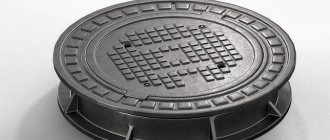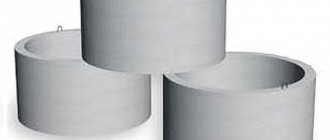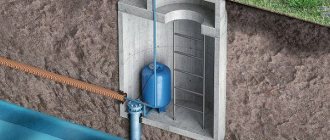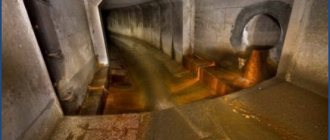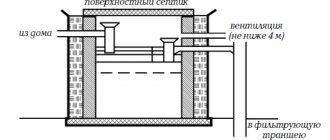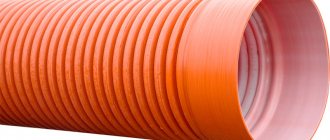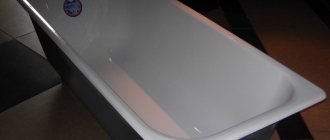Sewage hatches are engineering structures and are installed above wells of underground systems of city and storm sewerage systems, water supply, heating and cable lines, and main gas pipelines.
Hatches protect wells and drains from debris, foreign objects, and falling people and animals. Serve to provide free access during maintenance and repair of engineering systems. Ensure safety on highways, city streets, green areas and suburban areas. Designed for access to storage tanks when pumping sewage.
Fig.1. Sewer hatch.
Design, features and purpose
A sewer hatch is a monolithic or stamped product, usually round in shape, installed on a special ring-shaped neck in the upper part of a septic tank, pit or well. Depending on the device, it can be removable or folding - with hinges and a lock. In addition, the hatch structure may have two covers - one on top of the other. The inner one is equipped with a locking mechanism, the upper one performs the task of protection.
In general, such a hatch performs the following number of functions:
- Prevents accidents caused by people or animals falling into holes in the ground.
- Protects the container from various objects entering from the outside and subsequent clogging.
- Eliminates the spread of sewer odors in the surrounding area.
- Participates as an element of decoration of the exterior of the yard.
- Provides quick and reliable access when inspecting, cleaning and maintaining an underground tank.
- Creates reliable conditions for the passage of pedestrians and the passage of ground transport.
Strength of plastic hatch Source ytimg.com
Note! Before purchasing and installing a cover for a septic tank, you need to find out how much a sewer hatch weighs and what characteristics it affects. The further nature of the product’s operation will largely depend on this parameter. First of all, the heavier the product, the thicker and stronger it is, and the less likely it is that it will break when hit by a car and a stranger can easily open it or even steal it. For example, an ordinary cast iron hatch weighs about 100 kg.
Main functions of a sewer hatch
The main purpose of the products is to provide access to utilities laid underground, since sometimes there is a need for their preventive maintenance or repair. Shafts for various purposes, the shafts of which are closed with a lid, provide this opportunity.
In addition, sewer hatches:
- Provide security. A person or a car wheel will not accidentally fall into a closed well.
- They protect against debris and storm water infiltration, thereby increasing the service life of the equipment.
- Prevents the spread of bad odors from wastewater.
- Prevent possible damage and theft of valuable equipment. For this purpose, some types of products are equipped with locks.
It is prohibited to operate wells without hatches . During construction, mines must be closed.
Classification
Modern sewer manholes are classified according to several criteria:
- Type of material.
- Form.
- Weight and, accordingly, tensile strength.
- Type of locking mechanism.
- Size.
Let's look at each parameter in detail.
Material
Not only the weight of the sewer hatch, but also strength, service life, scope of application and price depend on the type of material. The four most commonly used bases are:
- Cast iron.
- Polymer.
- Concrete.
- Plastic.
Sewer manholes made of various materials Source glotr.uz
See also: Catalog of companies that specialize in water supply, sewerage and related work
Cast iron hatches are by definition strong and durable. They can withstand loads of up to 100 tons. At the same time, their service life is also quite high - at least 100 years. However, the price for this is the heavy weight of the product and the consumption of material, which complicates its installation and greatly increases the cost. Therefore, they are used mainly in places where heavy equipment passes - in production, highways, parking lots, etc. They are practically not used in the private sector.
Polymer hatches are made from synthetic resins mixed with sand filler. This composition is characterized by low density, lightness, and is resistant not only to temperature changes and seasonal fluctuations in precipitation, but also to chemically aggressive substances. In addition, they are distinguished by their affordable cost and good service life - at least half a century. Therefore, they are excellent for private areas.
Polymer hatches for sewerage Source tildacdn.com
Concrete hatches are characterized by a critically large mass and minimal tightness. However, they differ in maximum service life, ability to withstand loads and climatic factors of destruction. However, they are not widely available and are usually produced to order according to the specified sizes.
Plastic hatches are ideal for installing private sewer systems. They have minimal weight, low price, resistance to weather conditions, but at the same time they are not very durable. The permissible load limit is 1500 kg.
Form
Modern companies manufacture hatches for underground sewer tanks in the following basic shapes:
- Round.
- Square.
- Rectangular.
- Triangular, etc.
The most common products are of the first type. At the same time, the diameter of a round sewer manhole varies widely, but at the same time strictly corresponds to GOST-3634 99. Square and rectangular covers are also very diverse in size and, as a rule, their value is determined by the purpose and conditions of use in specific cases.
Round and square hatches Source oboiman.ru
Concrete
A concrete sewer hatch is used quite rarely. As a rule, the need for hatches made of this material arises in cases where the sewer well has a non-standard shape or size. In home sewer networks, concrete manholes are most often used to ensure the tightness of structures made using reinforced concrete rings. Since the mounting rim is also made of concrete, the structures fit well with each other.
For large networks, concrete manholes can also be used, but usually such cases arise when manholes are made in a non-standard shape. The hatch for such a system is made to order, in strict accordance with the project according to which the entire system is built.
Installation features
The technology for installing a sewer hatch consists of the following steps:
- Installation of the support ring on the base - using mortar or anchors - depending on the material of the hatch.
- Holding for a specified period of time to harden the concrete mass.
- Installation of the hatch directly.
- Construction of a blind area to remove atmospheric moisture.
- Lubricating contacting surfaces with lithol - to protect against freezing.
- Checking for proper operation - opening and closing, as well as testing the locking mechanism, if any.
Important! The type of material and size of the manhole have a direct impact on the installation procedure and quality. The larger and heavier the product, the more difficult and precise it needs to be installed. Incorrect installation will cause the heavy cover to warp. Because of this, it will be more exposed to destructive factors - weight loads during a collision, weather conditions, etc., which will significantly shorten its service life. In addition, it will no longer be able to ensure the tightness of the underground tank.
Specifications
When choosing a polymer lid, you should definitely pay attention to each technical characteristic of such a product. The main features are considered to be:
- Weight (this parameter is especially important);
- Type;
- Rated load.
It is important to have an idea of the permissible load class of the product, because the maximum value of the load that the product can withstand without damage depends on this parameter. Also, this value influences the choice of installation location. For example, a cover belonging to type “L” is a lightweight product that can withstand a maximum load of one and a half tons. Accordingly, such covers are not allowed for installation on the roadway. To close the drainage system shafts in courtyard driveways or parking lots, medium and heavy structures are used. Such products can easily withstand loads ranging from 15 to 25 tons.
You may also like: Sewer well - types and design
Briefly about the main thing
The sewer hatch is installed on a septic tank, well or cesspool and allows you to solve the following series of problems:
- Prevent people and animals from accidentally falling into an underground tank.
- Avoid clogging the container with various objects from the surface.
- Eliminate the release of unpleasant odors into the local area.
- Complement the design of the courtyard area.
- Provide convenient and fast tank maintenance.
- Create conditions for unimpeded passage and passage through the territory.
Sewage hatches vary in type of material, shape, weight, strength, size and design of the locking mechanism. Installation of the product must be carried out exclusively using proven technology, and it is better to entrust it to specialists.
Ratings 0
Round
Many people are interested in knowing why manhole covers are round. Since most manholes have a round neck shape, the use of predominantly round manholes to protect them is not surprising. The cylindrical shape of many wells is explained by the fact that work is carried out in this way much safer, and ventilation is of better quality. It is for this reason that round hatches are most often used to cover inspection shafts. When choosing a hatch, you need to carefully study all its operating parameters.
Application area
Polymer hatches are widely used in industrial, municipal and individual construction, in households, the main areas of application are:
Underground communications . Along the route of heating mains, gas, sewerage, water supply, electrical and telecommunications mains, technical wells are always installed for inspection and maintenance work, placement of control and measuring equipment, and storage of components. In all of the above cases, for protection and easy access, the wells are closed with polymer hatches, often with special locks to prevent unauthorized entry.
Private buildings . In households, to organize individual water supply, wells or boreholes are used, often located in underground caisson chambers. Many factory-made caissons have ready-made manholes made of plastic, providing protection and access to the internal space; sometimes they install similar underground chambers with their own hands, installing polymer sewer hatches on top. In individual households, home-made cellars located on the site, septic tank pits, and constructed wells at the points of connection (inset) to the centralized water supply, sewerage and gas mains are equipped with similar hatches.
Rice. 2 Plastic hatches with protection
How to make it yourself
Independently creating a reinforced concrete well cover does not allow you to achieve high strength of the product, but it makes it possible to significantly save money where some parameters can be neglected.
How to make a lid with a square hole 70 by 70 centimeters:
- Preparation of materials: M200 concrete, reinforcing bars, formwork board, plastic film.
- Digging a trench 10 centimeters deep in a free area of the territory with a diameter that exactly repeats the diameter of the upper ring of the well for which the cover is being created.
- Installation of formwork in the center of the trench to create a hole for the hatch.
- Covering the bottom and walls of the formwork structure with polyethylene.
- Pouring the first layer of concrete 5 centimeters thick.
- Laying reinforcement.
- Filling the second layer with a thickness of 5 centimeters.
- Drying concrete, proper care of it (after some time the product can be taken out and moved to a drying room).
A reinforced concrete well cover is an important and effective structural element, the selection and installation of which must be taken very seriously. In this case, the communication well and the slab covering it will last for many years, guaranteeing strength and reliability.
How to choose a well cover
Due to the fact that a well cover costs and weighs a lot, purchasing an unsuitable product or installing it and then dismantling it can take a lot of effort and money. Therefore, the choice of element must be approached carefully in order to immediately find what you need.
What to consider when choosing a well cover:
- Size – the diameter of the cover must exactly match the diameter of the well (or slightly larger): a smaller diameter will make installation ineffective, and a product that is too large will entail additional financial costs.
- The thickness of the lid is usually 10-20 centimeters. If it is planned that cars will drive on the cover and people will walk, it is better to choose a thicker thickness; for installing a regular well, 10 centimeters is enough.
- The shape of the hole for the hatch can be round or square (rarely rectangular). The standard option is a round hole with a diameter of about 70 centimeters; a square hole is chosen for installing a drainage grid.
- The location of the hole for the hatch is in the center or offset to the edge, the choice is determined only by ease of use.
- Appearance - the cover must be free of holes and chips, releases of fittings, cracks and other defects.
- Storage in a warehouse - it is allowed that there are a maximum of 6 products in a stack using wooden spacers, otherwise cracks may appear from the pressure of the weight, causing leaks.
With lock
Considering the theft of hatches, it is necessary to take care of their safety.
Therefore, it is quite logical to install a lock on it. Plus, it allows you to organize protection for the inspection well.
Advice! If its installation is carried out in a fenced local area, then a lock is not needed. If it is outside the fence, then it must be present.
To install the lock, you need to make a reliable frame. For sewer covers there are the following types:
- Spacer devices.
- Threaded connections.
- Flag.
This is interesting: Liquid for septic tanks and cesspools - review of products
